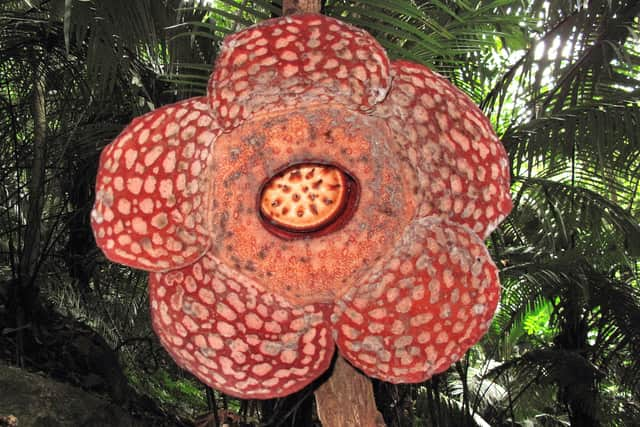Rafflesia: world's largest flower which smells like rotten meat at risk of extinction
and live on Freeview channel 276
A flower renowned for smelling like rotting meat is at the risk of extinction and scientists are calling for action to save it.
Known as Rafflesia, the flower produces the odour of decaying meat to attract flesh-eating flies. In total, there are 42 species of Rafflesia and scientists have warned all of them are under threat, with 25 classified as critically endangered and 15 as endangered.
Advertisement
Hide AdAdvertisement
Hide AdThe genus, which includes the largest flowers in the world, at more than a metre across – is at risk due to the destruction of forest habitats in south-east Asia due to factors such as deforestation and a lack of seed banking and propagation.


Scientists say that some new species of the parasitic plant may be getting destroyed before they are even known to science.
The flowers have five huge lobes, are reddish-brown with white spots, and appear for a week. It has no leaves, stems or roots, and does not photosynthesise. The flower uses long filaments that look like fungal cells to extract food and water from tropical jungle vines.
The flower also plays an important role in indigenous communities, being used to make an energy drink, increase fertility and as a cure for fever and backache.
Advertisement
Hide AdAdvertisement
Hide AdThey are found in areas of Indonesia such as Sumatra and Java, as well as parts of the island of Borneo, Malaysia, Thailand and the Philippines and pollinate via a thick, sticky liquid that dries onto flies.
According to a new study published in the journal Plants, People, Planet, more than two-thirds of Rafflesia are not being protected by current conservation strategies.
Dr Chris Thorogood, from the University of Oxford Botanic Garden, an author of the study, said the study “highlights how the global conservation efforts geared towards plants – however iconic – have lagged behind those of animals”.
“We urgently need a joined-up, cross-regional approach to save some of the world’s most remarkable flowers, most of which are now on the brink of being lost,” he said.
Advertisement
Hide AdAdvertisement
Hide Ad"An urgent, joined-up, cross-regional approach" is now vital to save the "world's most remarkable flowers".
The experts suggested a "multi-pronged" approach to save the flower - with local communities playing a vital role.
The researchers suggest an extension of conservation areas, propagation outside its natural habitat, ecotourism, and social media campaigns to establish it as an "icon" of plant conservation.
"A combined approach might just save some of the world's most remarkable flowers, most of which are now on the brink of being lost," said the authors.
Comment Guidelines
National World encourages reader discussion on our stories. User feedback, insights and back-and-forth exchanges add a rich layer of context to reporting. Please review our Community Guidelines before commenting.
